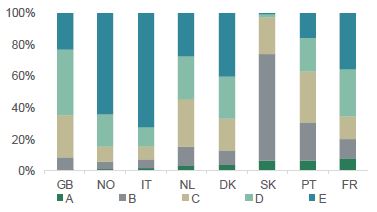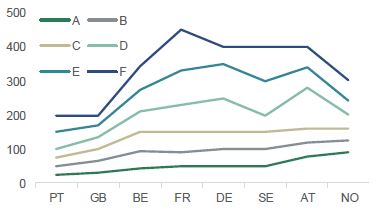
A leaked updated draft of the EU Taxonomy delegated act contains looser eligibility criteria that would be applicable to a wider range of buildings, but it could still exclude green bonds under several existing frameworks and has been deemed inconsistent and still overly restrictive.
The first public European Commission draft of the delegated act on technical screening criteria for parts of the sustainable finance Taxonomy regulation was published in November, and met with widespread criticism in relation to various aspects, notably green buildings. The biggest problem identified by market participants was a restriction, for existing buildings, on eligibility to those an energy performance certificate (EPC) class A within the key “acquisition and ownership” category of activities, since this would exclude many properties that had previously been considered sufficiently energy efficient to merit being eligible assets for green bonds, and moreover is not applicable to many commercial buildings in the EU, for which other, non-alphabetical classification methods are used.
The updated version of the delegated act makes two key concessions to these arguments. Firstly, for buildings built before 31 December 2020, the requirement is now either class A, or class B “provided that a study not older than 12 months demonstrates that the energy performance of the building is within [the] top 15% of the national or regional building stock”. Secondly, a footnote to this offers a criterion that can be used for buildings where the alphabetical classification system is not available:
“Where the EPC as set out in the applicable national law does not indicate a specific class and it is not possible to assess if the building is part of the top 2 classes in terms of energy performance, compliance with this requirement can be demonstrated through a study not older than 12 months attesting that the building is within the top 15% of the national or regional building stock.”
Several covered bond frameworks that would have likely fallen foul of the previous draft should meet the new criterion that allows class B as well as class A certified properties.
For example, the green bond framework of OP Mortgage Bank – which it inaugurated with a €750m deal on Thursday of last week (18 March) – features properties with A and B class EPCs and hence would comply with the draft’s screening criteria, and Sanna Eriksson, managing director of the Finnish issuer (pictured), said the development came as a relief.
 “It looks good and supports market practice,” she told Sustainabonds. “We do not see any major needs to change our framework.”
“It looks good and supports market practice,” she told Sustainabonds. “We do not see any major needs to change our framework.”
She noted that in Finland A and B class EPC properties together constitute about 10% of the housing stock, whereas only 1% are A.
However, some market participants – including those whose EPC criteria are encompassed by the updated draft – remain critical of the proposals.
Caja Rural de Navarra, for example, has A and B in the criteria for energy efficient buildings in its sustainability framework, but Miguel García de Eulate, head of treasury and capital markets at the Spanish cooperative bank, said the changes fall short of what is required to incentivise a real improvement in the energy efficiency of buildings.
“For issuers like us, whose framework already limits eligible mortgages to those within A and B, it is fine,” he said. “However, we must be clear: accepting only A and B is a tiny subset of the 15% best performing properties.”
Furthermore, the proposals disincentivise renovation, added García de Eulate.
“Some buildings which are below the 15% best threshold can reasonably aspire to reach the 15th percentile by way of a global renovation,” he said. “However, letters A and B mean in reality the 1% percentile in Spain, something simply out of reach – unless you completely rebuild it, which I guess is not a very realistic prospect.”
The 15% threshold has previously been accepted by industry bodies such as the Climate Bonds Initiative and the Technical Expert Group that advised the Commission on the Taxonomy as sufficient to constitute a significant contribution to mitigating climate change and had become market practice.
In the Spanish context, this would have allowed C and even some D class properties to be eligible, while existing covered bond frameworks including some from Norway and Italy include C class properties and would appear to be ineligible under the leaked draft – again, reflecting the make-up of the housing stock.
Distribution of residential building stock registered in the EPC database per label and country (%)

Source: Crédit Agricole CIB
An official at an issuer whose framework allows C class properties by virtue of these being within the top 15% said the updated draft fails to address another shortcoming of the original draft.
“An A or a B means completely different things across European jurisdictions,” he said, “so why do you have a one size fits all criterion for these letters in this EU Taxonomy?
EPC energy consumption levels by country (in kWh/m²/year)

Source: Crédit Agricole CIB
García de Eulate (pictured) said the reference to the top 15% in relation to the B class eligibility suggests the Commission has its criteria back-to-front.
 “If the objective is to ensure that performance is within the top 15%, and taking into account the differences in EPC’s letters thresholds among countries, wouldn’t it be much simpler, logical and fair, to require buildings to be within the top 15% and scrap the endless debate around specific letters altogether? Letters would just be a proof that the building is within the top 15%, which is what matters.”
“If the objective is to ensure that performance is within the top 15%, and taking into account the differences in EPC’s letters thresholds among countries, wouldn’t it be much simpler, logical and fair, to require buildings to be within the top 15% and scrap the endless debate around specific letters altogether? Letters would just be a proof that the building is within the top 15%, which is what matters.”
Under the leaked draft, the top 15% of “the national or regional building stock” will be able to be used as a criterion where it is not possible to assess whether a building is in the top two classes under national laws, if backed by a study in the previous 12 months, and market participants said this should address problems facing the commercial real estate sector in some countries where alphabetical scales are not used.
“That’s definitely good news,” said Bodo Winkler-Viti, head of funding and investor relations at Berlin Hyp, noting that the final official version will have to be awaited for confirmation.
He said that other issues that had been flagged as challenging for CRE – such as burdensome “do no significant harm” requirements – remained, but could be tackled by the industry.
Some market participants have also suggested the reference to the top 15% both in relation to B class EPCs and the footnote could offer some broader flexibility on eligibility.
Luca Bertalot, secretary general of the European Mortgage Foundation-European Covered Bond Council, said the leaked draft appears to have constructively taken on board most of the issues the industry has raised since the original draft was released.
“It is much better than the previous version, which was too ambitious for this industry,” he said. “My understanding is that this new version could accommodate green covered bonds and energy efficient mortgages in a more comfortable way.
“But of course, the devil is in the detail, and we are looking at this very carefully at how it will impact the different markets in different ways.”
The leaked draft is understood to have been circulated to EU member states and the European Parliament for pre-sounding ahead of its finalisation, which is expected around mid-April. As a delegated act, there is no process whereby it can be modified by either the European Council or Parliament afterwards.
Main photo credit: EC Audiovisual/Aurore Martignoni; Copyright EU 2020



